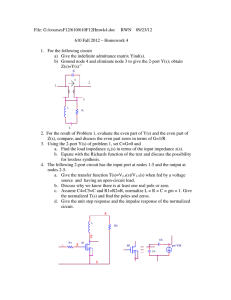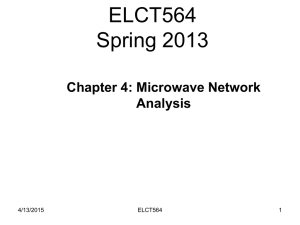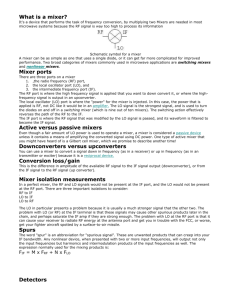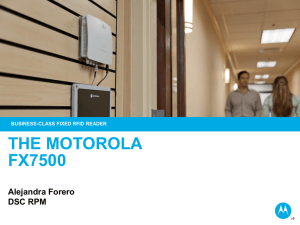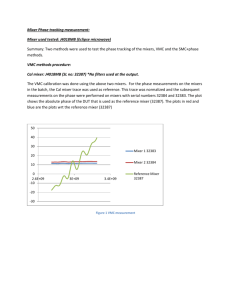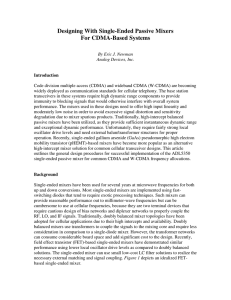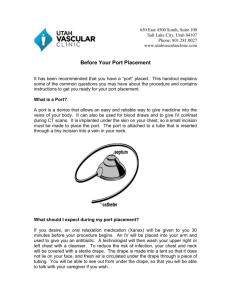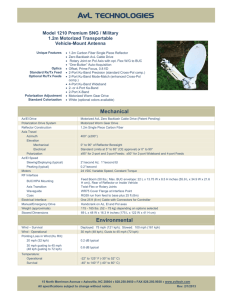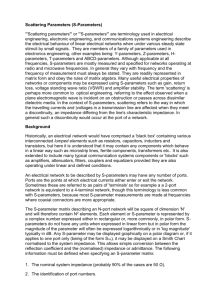review for elec 105 midterm exam #1 (fall 2001)
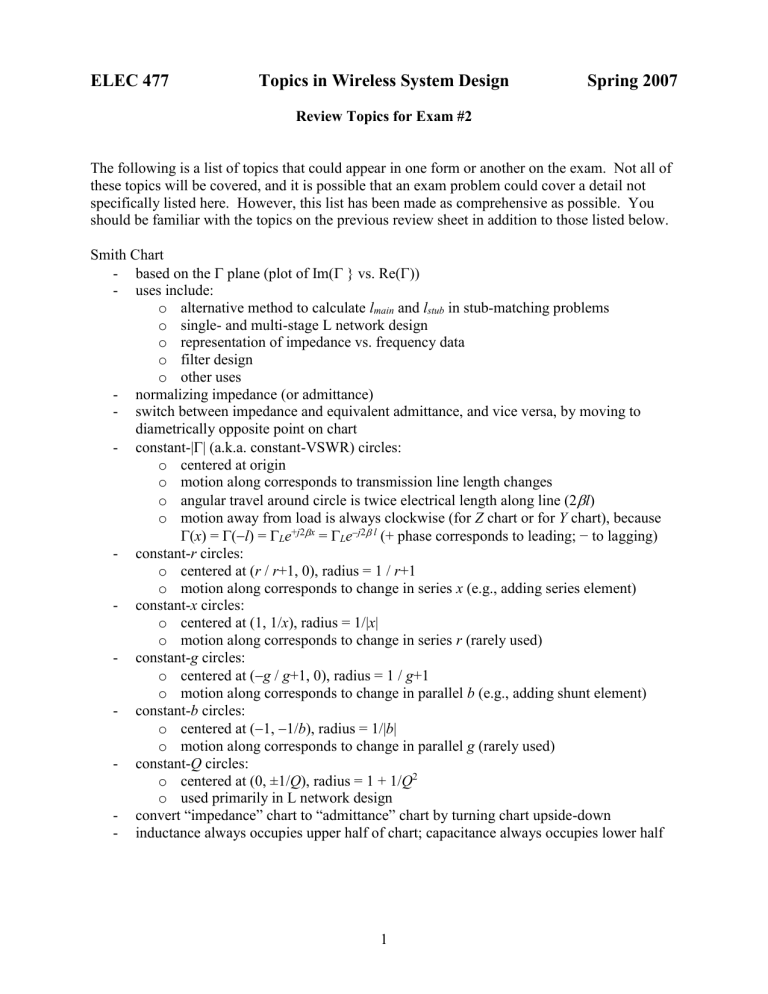
ELEC 477 Topics in Wireless System Design Spring 2007
Review Topics for Exam #2
The following is a list of topics that could appear in one form or another on the exam. Not all of these topics will be covered, and it is possible that an exam problem could cover a detail not specifically listed here. However, this list has been made as comprehensive as possible. You should be familiar with the topics on the previous review sheet in addition to those listed below.
Smith Chart
based on the
plane (plot of Im(
} vs. Re(
))
uses include: o alternative method to calculate l main
and l stub
in stub-matching problems o single- and multi-stage L network design o representation of impedance vs. frequency data o filter design o other uses
normalizing impedance (or admittance)
switch between impedance and equivalent admittance, and vice versa, by moving to diametrically opposite point on chart
constant-|
| (a.k.a. constant-VSWR) circles: o centered at origin o motion along corresponds to transmission line length changes o angular travel around circle is twice electrical length along line (2
l ) o motion away from load is always clockwise (for Z chart or for Y chart), because
( x ) =
(
l ) =
L e
+ j 2
x
=
L e
j 2
l
(+ phase corresponds to leading; − to lagging)
constantr circles: o centered at ( r / r +1, 0), radius = 1 / r +1 o motion along corresponds to change in series x (e.g., adding series element)
constantx circles: o centered at (1, 1/ x ), radius = 1/| x | o motion along corresponds to change in series r (rarely used)
constantg circles: o centered at (
g / g +1, 0), radius = 1 / g +1 o motion along corresponds to change in parallel b (e.g., adding shunt element)
constantb circles: o centered at (
1,
1/ b ), radius = 1/| b | o motion along corresponds to change in parallel g (rarely used)
constantQ circles: o centered at (0, ±1/ Q ), radius = 1 + 1/ Q 2 o used primarily in L network design
convert “impedance” chart to “admittance” chart by turning chart upside-down
inductance always occupies upper half of chart; capacitance always occupies lower half
1
Simple Band-Pass Filters
fraction of available power delivered to load:
P
L
P
A
R
4 g
R g
R
L
R
L
2
series RLC :
o
parallel RLC :
o
1
1
1
LC
,
2
1
o
2
2
R g
2
L
R
L
1
LC
,
R g
1
R
L
, Q net
C
, Q net
o
o
R g
o
L
R
L
X
L
2 R sys
R g
R
L
o
C
R sys
2 X
C
stop-band roll-off = ±20 dB/decade (±6 dB/octave)
Coupled-Resonator Band-Pass Filters
maximize stored energy relative to energy dissipated per cycle (i.e., maximize Q)
larger Q (narrower bandwidth) for given resonator reactances
top (series)-coupled parallel LC resonators
shunt-coupled series LC resonators
difference between “network” Q ( Q net
) and “transformation” Q
Matrix Representations of Networks
equivalent circuit models at VHF, UHF, microwave frequencies are very complicated, but they apply over wide frequency ranges
matrix representations are simpler (only 4 needed for 2-port device), but valid at only one frequency (lists of parameters required for wideband applications)
typically represent voltage-voltage, voltage-current, and/or current-voltage relationships at the network’s terminals
definitions of port voltages and currents for a 2-port:
I
1
I
2
+
V
1
−
2-port network
+
V
2
−
Z (Impedance) Parameters: o system of equations (2-port):
V
1
V
2
Z
11
I
1
Z
21
I
1
Z
12
I
2
Z
12
I
2 o calculation of coefficients: Z ij
V i
, where I j
all port currents but the j th
I j
I j
0 o measurements of Z parameters require open -circuit port terminations
Y (Admittance) Parameters: o system of equations (2-port):
I
1
I
2
Y
11
V
1
Y
21
V
1
Y
12
V
2
Y
12
V
2 o calculation of coefficients: Y ij
I i , where V j
all port voltages but the j th
V j
V j
0 o measurements of Y parameters require short -circuit port terminations
2
S (Scattering) Parameters: o general system of equations (2-port): b
1 b
2
S
11 a
1
S
21 a
1
S
12 a
2
S
12 a
2
, where a i
V iI
Z oi
(normalized incident voltage), and b i
V iR
Z oi
(normalized “scattered,” or “reflected” voltage) o calculation of coefficients: S ij
b a j i a j
0
, where a j
all inc. voltages but the j th o If all port impedances are the same, then S ij
V iR
(frequently true)
V jI
V j I
0 o care must be taken when finding V iI
and V iR o measurements of S parameters require impedance-matched port terminations o de-embedding (modification of S parameters due to addition of lossless line lengths): l
1 l
2
Z o
2-port network
Z o
S
11
S
22
1
2
S
11
S
22
e e
j
2 j
2 l
1 l
2 S
S
12
21
l
1 l
1
,
, l l
2
2
S
12
S
21
e e
j
j
l
1 l
1
l
2
l
2
makes possible the practical use of vector network analyzers
interpretation of S parameters o on-diagonal parameters are reflection coefficients o off-diagonal parameters are gains/attenuations o S parameters are voltage ratios, not power ratios
relationships between matrix representations o o o
S
S
Y
Z o
1 o
1
1
o
o
, where [ Y o
] is a diagonal matrix w/port admittances
, only if all port impedances are the same, where [ Z o
] is
a diagonal matrix w/port impedances reciprocity: Z ij
Z ji
, Y ij
Y ji
, and S ij
S ji
Receiver system design considerations
- front end design of typical superheterodyne receiver
- homodyne (direct conversion) receiver
- advantages of frequency translation (heterodyning) as opposed to TRF architecture o allows optimization of narrow filter at a single, stationary IF instead of moving the pass-band of the filter o total receiver gain can be distributed among different frequency ranges (e.g., some at RF, some at one or more IFs; some at baseband), which aids stability o tuning accomplished by moving the frequency of a single oscillator; in general, filters’ pass-bands do not have to be tuned
3
Nonlinear behavior of amplifiers (intermodulation distortion, or IMD)
- representation of output signal as Taylor series v out
a
1 v in
a
2 v 2 in
a
3 v 3 in
, where a
1
, a
2
, a
3
, … are constants
- 1st-order products are linear outputs
- 2nd-order, 3rd-order, etc. are intermodulation products
- dB level of 2nd-order products increases two times as fast as that of 1st-order products as input power increases (output power of desired signal is directly proportional to input power, but IM2 products are proportional to input power squared)
- dB level of 3rd-order products increases three times as fast as that of 1st-order products as input power increases (output power of desired signal is directly proportional to input power, but IM3 products are proportional to input power cubed)
- third-order intercept point (TOI or IP3 or P
3
), referred to input or output
- 1-dB or 3-dB compression point (or compression level)
- IMD products are troublesome only when they emerge from noise floor of amplifier
- 3rd-order products are of most concern, because the signals that cause them can pass through front-end filter of receiver or amplifier
Mixers
- primary purpose is to provide frequency translation (frequency shifting)
- two inputs: RF signal and LO signal
- second-order outputs are signals at sum and difference frequencies (of RF and LO) f
IF
f
RF
f
LO
(summing mixer) or f
IF
f
RF
f
LO
(differencing mixer)
- IF and LO range selection f
LO
f
IF
f
RF
(summing mixer) or
- high-side injection:
- low-side injection: f
LO
f
RF f
LO
f
RF f
LO
f
RF
f
IF
(differencing mixer)
- diode ring mixer (doubly balanced; provides isolation of input/output ports)
- image frequencies and image bands
- image rejection mixer
- cos(
x ) = cos( x ); relevant when argument of cosine includes a negative frequency difference, which is nonphysical
Relevant coursework, textbook sections, and supplemental material:
Homework: #5-#7
Labs: #5-#9 (although little to nothing unique to the labs will be on the exam)
Textbook: Sec. 3.4
Chap. 5 (except Secs. 5.5, 5.7, 5.9, and 5.15)
Chap. 6 (except Secs. 6.4 and 6.6)
Sec. 10.13
Supplements: Drawing Q Circles on the Smith Chart
Basic Band-Pass Filters
Basic LC Coupled-Resonator Filters
Example: Calculation of S Parameters
Intermodulation Distortion
Mixer Circuit Operation
Mixers and Mixer Performance
Mathcad: (none)
4
